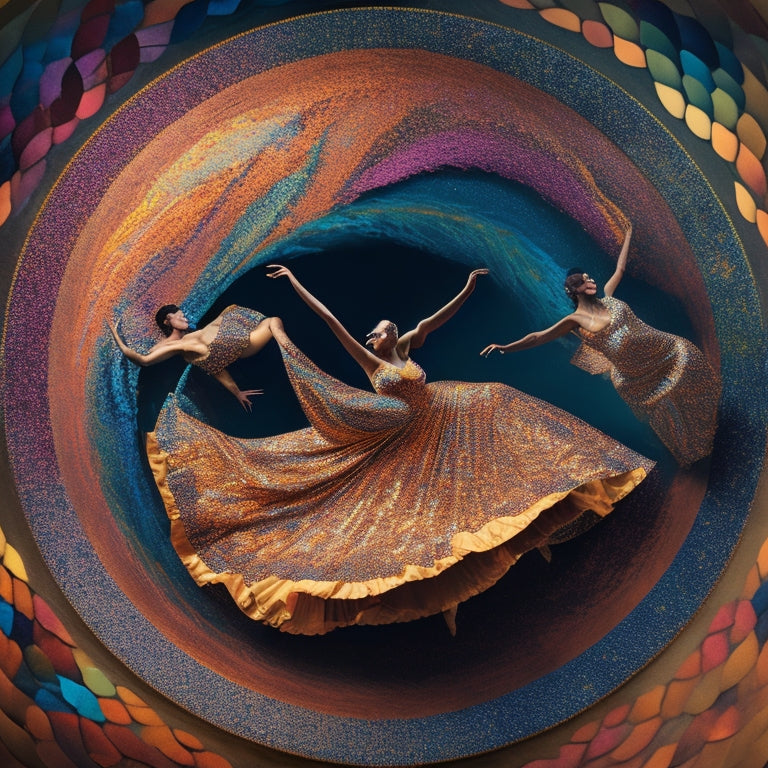
The Cultural Tapestry of Dance Explained
Share
Dance is a rich cultural tapestry, woven from threads of tradition, identity, and narrative, reflecting human experience's diversity and complexity. Cultural identity is expressed and reinforced through dance, reflecting values, ethnicity, gender, and social status. As a cultural expression, dance embodies narratives, myths, and legends, communicating values, beliefs, and traditions. Across cultures, dance reflects historical, social, and aesthetic contexts, with traditional movements evolving into modern interpretations. The cultural tapestry of dance is enriched by exchange, fostering cross-cultural understanding. As we explore the intricate patterns of dance, we unravel the beauty and complexity of human culture, revealing many more secrets waiting to be uncovered.
Key Takeaways
• Dance is a cultural expression that embodies narratives, myths, and legends, conveying values, beliefs, and traditions across linguistic and cultural barriers.
• Ethnic traditions and historical contexts influence dance styles, reflecting cultural identity and social status.
• Ritualistic dances evolve into modern interpretations, preserving cultural heritage while fostering cross-cultural understanding.
• Choreography, gestures, and costumes reveal cultural codes and values, celebrating the richness of human experience.
• Cultural exchange enriches the dance landscape, weaving unique narratives that reflect the diversity and complexity of human culture.
Dance and Cultural Identity
As a reflection of cultural values, dance serves as a powerful medium for expressing and reinforcing important aspects of identity, including religion, ethnicity, gender, and social status.
Ethnic traditions, for instance, are often reflected in dance styles, such as the traditional Tahitian dances that enforce gender distinctions, with men traditionally taking the lead.
Gender roles are also reinforced through dance, with certain styles or movements reserved for specific genders.
In addition, dance holds ritual significance, symbolizing social status and cultural identity.
In this sense, dance is a powerful tool for social symbolism, conveying cultural values and beliefs through movement and expression.
Dance as Cultural Expression
Through its intricate choreography, nuanced gestures, and symbolic costumes, dance embodies the cultural narratives, myths, and legends that shape a community's worldview. As a cultural expression, dance communicates the values, beliefs, and traditions of a community, transcending linguistic and cultural barriers.
Dance and tradition are inextricably linked, with each culture weaving its unique narrative through movement, music, and attire. By examining the choreography, gestures, and costumes of a particular dance, we can decipher the underlying cultural codes and values that shape its identity.
As a powerful medium of communication, dance conveys cultural nuances, preserving and transmitting cultural heritage from one generation to the next.
Dance Across Cultures
Across cultures, dance assumes diverse forms, reflecting the unique historical, social, and aesthetic contexts in which it emerges.
Traditional movements, such as Indian Bharatanatyam or Japanese Kabuki, have evolved over time, incorporating Modern interpretations that blend cultural heritage with contemporary sensibilities.
Similarly, Ritualistic dances, like the Native American Ghost Dance, have given rise to Contemporary adaptations, reinterpreting ancient traditions for modern audiences.
This cultural exchange has enriched the dance landscape, allowing diverse communities to express their distinct identities through movement.
As dance transcends linguistic and cultural barriers, it fosters cross-cultural understanding, celebrating the richness of human experience.
Frequently Asked Questions
How Does Dance Serve as a Form of Storytelling Across Cultures?
"Contrary to spoken word, dance transcends linguistic barriers, conveying emotional expression and cultural heritage through kinetic storytelling, weaving a rich tapestry of cultural identity, tradition, and collective memory across cultures."
Can Dance Be Used as a Tool for Social and Political Change?
Through the lens of dance, social and political change can be facilitated, as seen in the Protest Movement, where dance serves as a powerful tool for Community Empowerment, mobilizing individuals and fostering collective action towards a common goal.
What Role Does Music Play in Shaping the Cultural Significance of Dance?
In the Afro-Caribbean tradition, music plays a pivotal role in shaping cultural significance, as rhythmic identity and sonic heritage converge to evoke ancestral roots and spiritual connections, exemplified in the polyrhythmic complexity of Haitian Vodou ceremonies.
How Does the Cultural Context of a Dance Style Impact Its Aesthetic Principles?
The cultural context of a dance style profoundly influences its aesthetic principles, as seen in Ritual Fusion, where diverse traditions blend, and Symbolic Expression, where movements convey cultural narratives, shaping the dance's artistic essence.
Can Dance Be Used as a Form of Cultural Preservation and Historical Record?
As cultural custodians, dance serves as an essential archival medium, preserving heritage legacy and folk traditions, allowing future generations to connect with their ancestral roots, thereby safeguarding cultural identity and historical record.
Related Posts
-

5 Time-Saving Hacks for Busy Makeup Artists
You're a busy makeup artist juggling multiple tasks, from client appointments to kit maintenance and continuous skill...
-

Best Ballroom Dance Shoes for International Style
When you're selecting the best ballroom dance shoes for International Style, focus on essential features like grip, c...
-

Innovative Therapy: Dance Movement's Healing Power
Dance movement therapy is a creative and evidence-based approach that harnesses the transformative power of movement ...


